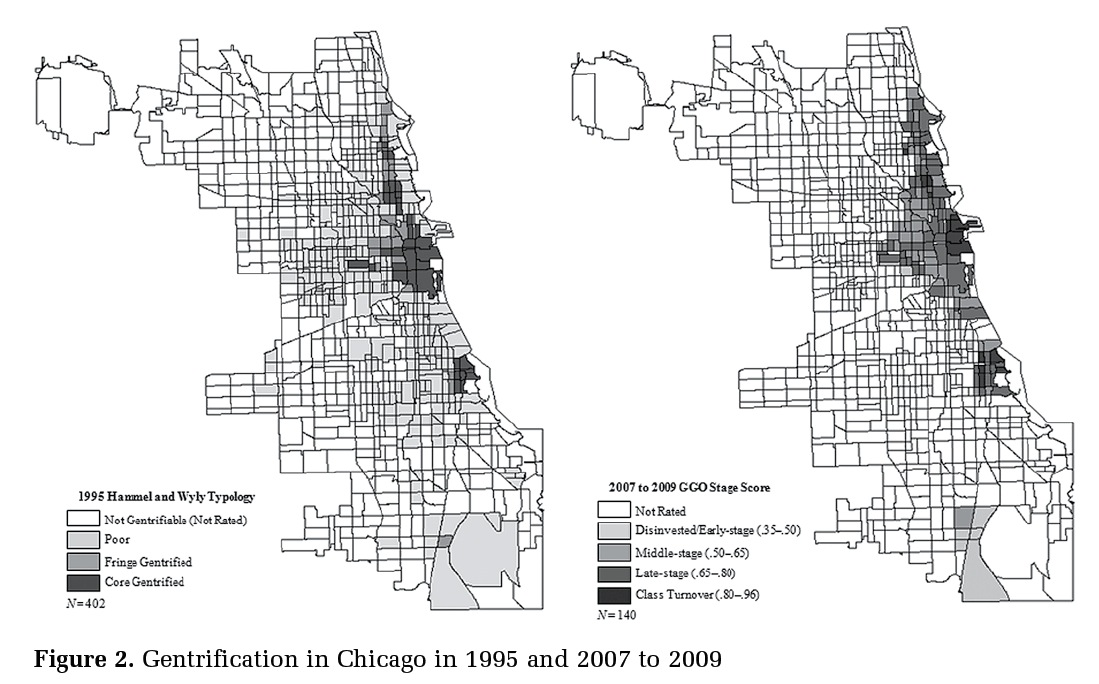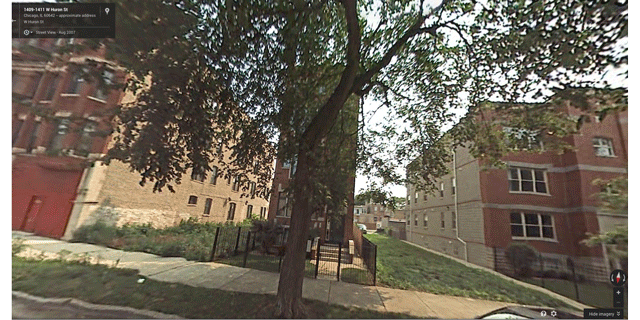Google Street View is an excellent way to watch your neighbourhood change. In fact, we’ve conducted our own informal surveys of urban transformation in Detroit, San Francisco and Brooklyn. While our investigations were based on casual observation, now a pair of sociologists from Harvard are using Google Street View data to measure gentrification — and predict if those trends will continue.
As part of a new study published in American Sociology Review, Jackelyn Hwang and Robert J. Sampson tracked the movement of middle- and upper-middle-class residents into Chicago neighborhoods that have previously shown signs of economic decline. But Hwang and Sampson are not studying migration patterns specifically — rather, they’re examining the real-life results. Using Google Street View, they were able to virtually tour thousands of streets, looking for visual signs of reinvestment and renewal from 2007 to 2009.
The fact that Hwang and Sampson have codified these features into an instant assessment system using only Google’s images is what’s so interesting. Instead of the cold hard data of a Census report, Hwang and Sampson have been able to create a more qualitative, nuanced definition of gentrification based on observation. They managed to isolate three different groups of indicators found on Google Street View images — structural mix, beautification, and lack of disorder and decay — to rank each block. Hwang herself hand-coded about 2,500 blocks for all these indicators (you can see her entire coding guide here), and by the end she was able to “read” a block in about a minute.

Examples of various stages of gentrification from the study. Block face 1 for example, scored lower due to sandblasted brick, boarded up windows, and graffiti.
It’s fascinating to see the familiar hints of gentrification divided up into these metrics. The structural mix includes the details that Hwang and Sampson are able to see based on architectural cues. For example, “sleek, geometric, glass or steel exterior materials” and “reconstructed or restored porches and balconies” mean that a building has been renovated or is entirely new, while “ornate detailing” and “aluminium siding” are signs that the property is older and has not been taken care of. They also look at the presence of particular land uses like converted industrial buildings (warehouses turned into lofts, for example) and luxury high-rises.
The study also takes into consideration the details around the properties themselves, where things like speed bumps and bike lanes are proof of public investment and therefore boosted the block’s rating. The presence of trash and graffiti, both easily seen from Google’s cameras, resulted in a lower score.
One indicator that had to be thrown out due to the time period — remember, this was the start of the real estate bust — were “for sale” signs. “We just assumed that newly built houses for sale were developers promoting gentrification, but as I researched Chicago’s real estate market more, I saw that they’d overspeculated and overbuilt these houses,” says Hwang. “They’re for sale because they couldn’t sell them to anyone.”

Comparing gentrification indicators using traditional methodology in 1996 and the new Google Street View method
After assigning each block a “degree of gentrification,” Hwang and Sampson compared the 2007-2009 study with a similar one in 1996. In fact, one of the reasons they chose Chicago is because it had been so well-documented by similar pre-Street View research. Sampson had even led a study in 1995 focusing on crime and disorder where he drove around in SUVs and filmed city blocks with a camcorder. Compared to 1996, they could clearly see the patterns of gentrification intensifying in certain neighborhoods and sometimes spreading to adjacent ones.
But in several cases, even after accounting for variables like transportation, crime, and even perception, gentrification did not grow in neighborhoods as predicted, says Hwang. “They all had showed signs of gentrification or were next to ones that did, and you’d think it would have spread — but it didn’t.”
Hwang and Sampson looked into more detailed information about those specific neighborhoods to see what they had in common. When cross-referencing their predictors for gentrification with actual population and city data, they found some unsettling trends. While they could clearly see which blocks had showed early signs of gentrification, the process was only likely to continue if at least 35 per cent of the residents were white. Even if some gentrification signs were present in neighborhoods that were 40 per cent or more black, the process slowed down or eventually stopped.
While this does seem to reinforce the stereotypical view of gentrification (white residents moving in to a neighbourhood will change its fate), Sampson says it proves something slightly different. “Predominantly black, seriously discriminated-against neighborhoods in Chicago and many other American cities aren’t reaping the same benefits from the transformation of cities,” he says. “So rather than saying you need whites, I think what is needed — and this has always been the case — is some concerted effort to rethink urban policy.”
Besides the obvious discussions about race and economic policy that this study is sure to provoke, it also makes a case for this new way to measure “gentrification,” which is so often seen as a bad word. When defined by Hwang and Sampson’s methods, gentrification is really about urban investment, which almost always yields a positive transformation for local residents. Using these images, it’s a transformation you can see — or not see — for yourself. [Harvard Gazette]
